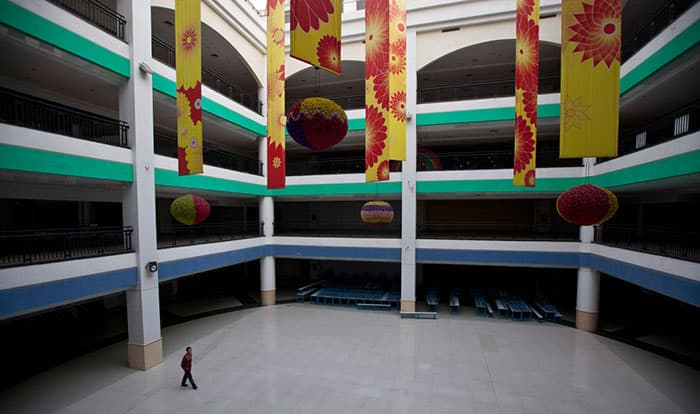
The New South China Mall is the most famous of the country’s ghost malls
This post is part of a series highlighting content in Mingtiandi’s China Mall 2020 white paper. Find out more about this retail research report here.
China’s retail sales more than tripled from RMB 6.7 trillion in 2005 to RMB 27 trillion in 2014, helping to create one of the world’s largest consumer markets, according to government statistics.
Along with this three-fold growth in consumption came a corresponding expansion in retail space that gave birth to retail real estate giants such as Wang Jianlin’s Dalian Wanda, as the country’s decades-old storefronts and markets rapidly gave way to indoor shopping centres.
However, despite tapering growth in retail sales since 2010, China is now staring at a bulging pipeline of more than 40 million square metres in new mall space expected to enter the market in the next three years, according to research by JLL.
While many of mistakes made early in China’s retail development may have mainly been folly on the part of developers, a series of conversations by Mingtiandi with regional retail real estate professionals reveals that the hand of state-planners and local governments has also led to over-building and a penchant for high-end projects.
Retail Space Shortage Helps Developers Grow Quickly

Dalian Wanda’s Wang Jianlin rode to riches partly on China’s need for more malls
During the recent consumption boom, China’s new-found prosperity has transformed its retail footprint. Now China’s largest retail developer, Wanda built its first mall in 2000, and by 2006 had just a handful of shopping centres around the country. By the end of 2014, however, the company had built its 100th Wanda Plaza, and this year announced plans to build 900 more.
Wanda was helped in this rapid growth by a severe shortage of retail space.
As recently as 2008, China maintained roughly half of the number of retail venues as in the US at 549,000 in the mainland, compared to 1.1 million in the United States. Those shop numbers translated to an average of 3,620 stores per million Americans but only 416 stores per million Chinese. The retail situation in China was particularly inadequate for consumers living outside the country’s largest cities.
As consumption expanded, the country’s traditional shopping streets were becoming even less adequate for the needs of Chinese consumers, creating demand for new retail real estate projects.
Fast Growth Leads to Ghost Malls and Other Lessons
While China was successful in putting up many new shopping centres in a short period of time, many of these malls have been hastily built by developers whose primary previous experience had been with residential projects.

Guohua Jean Zhang of Taubman Asia
The result of this mall rush has been a rash of struggling shopping centres and cases of ghost malls such as the now famous 660,000 square metre New South China Mall in Dongguan, Guangdong. The shopping centre, which is the world’s largest by leasable area, was opened in a rural district of a second-tier city, and sat largely vacant after it was opened in 2005, until it was remodelled and said to be ready for relaunch this year.
Projects like the New South China Mall, which was sold by its original developer in 2006, reflect inexperience by developers, as well as – in this case – the exuberance of a new billionaire.
“The first generation of shopping mall development reflected Chinese developers’ general inexperience in planning, leasing, and operations,” notes Guohua Jean Zhang, Managing Director, China at developer Taubman Asia. “Many old generation malls opened in poor locations, featured poor internal circulation, and were strata-titled.”
Indeed, the New South China Mall project was originally built by a company headed by Hu Guirong, who had became a billionaire in the instant noodle industry.
While the New South China Mall is an extreme example, China’s fast growth in retail, combined with its large population, has led to ever larger shopping centres on the mainland.
According to JLL research, the average size of new shopping malls in Shanghai alone has doubled over the past 15 years, from 40,000–45,000 square meters to 90,000 square meters today. On average, mall sizes across China are 95,000 square meters, at least 30 percent larger than other countries.
Marketing Malls Like Selling Apartments
When residential developers came into the mall industry, they brought with them a revenue model based on selling individual units to the public as a way to generate quick cashflow and fund rapid construction of more projects.
This strata-title approach to mall development, while creating fast cashflow for the developer, also led to many properties being undermanaged, inadequately maintained, and poorly thought out.
“If you have individual units owned by individual investors, then what they’ll tend to do is they’ll lease out to the person who pays the highest rent,” explains James Macdonald, Head of Research, China at global real estate services provider Savills. “The decisioning at the mall in terms of the tenant mix and also whether it’s mid or low or high tends to get very confused and it sends a mixed signal to consumers. You can’t have a stationery store next to an LV store – it sends the wrong signal in terms of what the mall is.”
In addition to being sold off in individual units, these new projects were often put together without adequate research about local traffic flows or shopping patterns. Plans for new projects were often frequently made without consideration of other developments in the pipeline within the vicinity.

Ng Beng Tiong of ARA Asset Management
This lack of planning resulted in localised overcapacity, substandard mall design, or the incorrect mall size in the wrong locations for shoppers. Many of these malls were also developed in new areas before the necessary transport infrastructure was in place.
“The surge of retail mall supply in the past few years and for the foreseeable future was not entirely demand driven,” notes Ng Beng Tiong, Assistant Group CEO and CEO of ARA Private Funds at the Asian real estate fund manager ARA Asset Management, a real estate fund manager. “Coupled with a shortage of retail talent in the fledgling retail industry, a situation of over-supply, poorly designed and operated malls, misplaced malls, wrongly sized malls, and malls that don’t cater to local needs, can be seen across the country.”
This loosely organised approach to retail development has led to disappointing performance for many mall projects, and as a consequence, retailers and consumers are gravitating towards single-owner shopping centres.
Malls Built for Governments Instead of Shoppers
Another factor that has led to challenges for China’s retail real estate industry has been the need for developers to satisfy local government planners before breaking ground on their new shopping centre.
As a result, much of the rapid mall development in recent years has been driven by local government revenue targets, rather than developer plans or consumer needs.

Sam Crispin of PwC
During the early years of China’s real estate boom, local governments initially sold plots of urban land purely for residential development. However, cities and districts soon came to realise that this approach limited ongoing taxation and employment benefits. As a consequence, governments switched to pushing larger plots of land for mixed use development, usually incorporating a large retail element.
“The bigger the shopping centre, the more potential revenue in theory that the local government can get from business tax, from sales in the shopping centre, and rental income, all of which is taxable,” says Sam Crispin, Director for Urbanisation Services at professional services company PwC. “Increasing tax revenue is one of the objectives of city planners, so sometimes they appear to plan big shopping centres whether they are commercially rational or not.”
Many developers flourished through strong government connections, with the governments often going directly to developers to draw up plans as sites came to market. However, aggressive government plans didn’t always translate into consumer demand, particularly given the large mall size frequently demanded by the local planners.
“The overall scale of the shopping centre might be viable if it’s built over a period of time but not if it’s built at once,” adds Crispin. “You sometimes have massive suburban shopping centres, which could have been built in phases rather than all been built at once, and that might be more commercially viable than what often happens is a large shopping centre being built all in one go.”
A Flood of New Supply Brings New Retail Priorities
With China’s current stock of malls under construction equalling more than 30 percent of the country’s present stock of shopping centre space, prospering in China’s retail real estate market between now and 2020 will require more alignment with market forces than it will connections with local governments.
“Now, we have so many malls that it’s not easy anymore,” says Steven McCord head of China retail research for JLL. “It’s also increasingly realised by developers that you can’t just build a mall in some random place and fill it up with Gucci, Prada, and LV because it isn’t going to happen”.
Instead, as McCord points out, the purpose of China’s malls today is changing. They are responding to an increasingly selective and savvy consumer by providing more interactive aspects, including entertainment, leisure, a variety of food options, lifestyle needs, and unique concepts that bring points of differentiation to their mall amid a highly competitive retail real estate environment.
Mingtiandi’s China Mall 2020 report was sponsored by Taubman Asia. For more information about the project, or to download the full report, just click here.
Leave a Reply